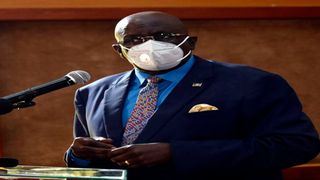
Education Cabinet Secretary Prof. George Magoha.
| Francis Nderitu | Nation Media GroupEducation
Premium
This is how junior secondary school under CBC will look
Many parents and some stakeholders are in the dark over the new structure of secondary education under the competency-based curriculum (CBC). The changes will fundamentally alter the structure and content that learners will be exposed to. Education senior writer David Muchunguh explains some of the pertinent issues that you need to know.
What is junior secondary school?
The new structure of education through which the competency-based curriculum (CBC) will be implemented will be 2-6-6-3. Learners will spend two years in pre-school, six years in primary school, six years in secondary school and three years in university (tertiary). Secondary school has been split into two levels; junior and senior. Junior secondary will comprise Grades 7,8 and 9 while senior secondary will be Grade 10,11 and 12.
Where will junior secondary be domiciled?
It will most likely be domiciled in the current secondary schools which means the learners in Grade 5 will join secondary in January 2023 after completing their primary education in December next year. There is also a provision for private investors to establish stand-alone junior secondary schools.
Why was primary school shortened by two years and secondary school expanded by two years?
The time learners spend in primary school was shortened to conform to international best practice. The assumption is that learners will have acquired enough knowledge at the end of primary to prepare them for secondary education where they will spend more time to master their preferred areas of learning. From the benchmarking that the Kenya Institute of Curriculum Development (KICD) undertook, primary education ends at Grade 6 or 7 in most countries. In the East African Community (EAC), only Kenyan learners take eight years in primary school.
Why was secondary education split into two stages?
The main reason was to expose learners to broad curriculum content to enable them choose their preferred pathways in senior secondary. It aims at avoiding wasting too much time on subjects a learner has little interest or is not gifted in. The restructuring was also to comply with international best practice. Kenya is also a signatory to the EAC protocol on harmonisation of the education curricula, standards, assessment and evaluation of education programmes. As such, Kenya had to align its system. Other EAC member countries are also at various stages of reforming their curricula to comply with the protocol.
Has such a structure been used elsewhere?
Countries that were used for benchmarking where primary education ends at Grade 6 include Canada, South Korea, Ghana, South Africa, Singapore, England, Malaysia, China, Finland, Rwanda and Zanzibar. In Uganda and Tanzania Mainland, learners study up to Grade 7. In other EAC member countries, secondary education is also split into two.
Won’t junior secondary school learners be too young to transit to secondary school?
It is expected that learners in this level will be in the age bracket of 12 to 14 years. They will be relatively younger than the current average age of joining Form One at 14 years. Learners in Kenya stay in primary school longer than most countries in the world.
Will the learners be in day or boarding schools?
Junior secondary learners will be in both day and boarding schools. The majority of them will, however, be in day schools, a situation the government also favours. Day schools are considered affordable by many households and cost-effective to run by the government.
Are secondary schools ready for the transition?
As at now, secondary schools are not ready for the transition. However, the process of getting them ready has started. In terms of infrastructure, secondary schools will need extra classrooms since learners will now be in school for six instead of four. Schools will also be expected to invest heavily in science and technology laboratories as there is emphasis on the subjects under CBC. The government has planned to construct 10,000 new classrooms to accommodate the increased enrolment. The training of secondary school teachers on CBC implementation will begin in March this year. However, since there is already a shortage of teachers, more must be employed.
How many subjects will the learners study in junior secondary?
According to the Basic Education Curriculum Framework (BECF), learners in junior secondary school will be “exposed to a broad-based curriculum to enable them explore their abilities, personalities, interests and potentials. This is intended to form the basis for effective identification of career paths, talents and interests in preparation for transition to senior secondary school”.
How will the learners be placed in secondary schools?
Placement will be based on formative and summative assessments. There will be three formative assessments at the end of Grades 4,5 and 6, all of which will be weighted at 20 per cent. A final assessment (summative) will be administered at the end of Grade 6 to make up the other 40 per cent.
The Ministry of Education has, however, not yet declared how the placement will done and how it will solve the stiff competition for places in top-performing schools.
How else will learners’ lives be affected by the changes?
There will be socio-cultural changes in the learners’ lives. For many communities that practise circumcision as a rite of passage, this is done after boys complete Standard 8. This might now have to change to be done at the end of Grade 6.





